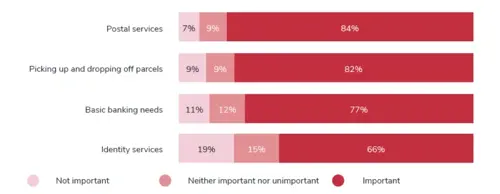5.3. Ensuring convenience for consumers – particularly for postal services
In addition to the role that they play as a social hub for communities, post offices also serve consumer hubs, enabling ease of access for millions of people each week. Indeed, Post Office is unique in terms of the convenience that a single business offers to consumers by virtue of the number and reach of its branches across the country.
On average, consumers are willing to pay nearly £30 a year to stop their nearest post office from moving just one mile further away.
This research revealed the accessibility of the Post Office network to be of significant importance to communities. On average, consumers are willing to pay nearly £30 a year to stop their nearest post office from moving just one mile further away. The breadth of the branch network brings substantial benefits to communities. Importantly, it brings essential services within reach of consumers and, as a result, also allows them to carry out their everyday tasks and activities nearby and in their local area – without having to travel to the next town or village, or to out-of-town shopping centres. The findings here show that this is strongly valued by communities, demonstrating the importance of Post Office remaining local and the value of having an in-person presence.

Post Office is unique in terms of the convenience that a single business offers to consumers by virtue of the number and reach of its branches across the country.
It is little surprise then that this research found consumers across the United Kingdom continue to regularly rely on Post Office, with one in 10 consumers using it at least once a week, while one in three uses a post office at least monthly. More widely, the vast majority of consumers use a post office at least once a year (89%). Whilst Post Office is of varying importance to different communities and individuals within those communities, from being relied on to carry out essential day-to-day tasks to being used every so often, almost the entire United Kingdom resident population interacts with Post Office at some point every year – a claim that few other single retail organisations can make.
This research highlighted the value of three Post Office qualities in particular. First, the consumer and SME surveys confirmed the importance of proximity of post offices, with around six in seven consumers and SMEs (85%) believing it is important for a post office to be nearby and convenient to get to. This meant it was the most valued characteristic of Post Office for consumers, and second behind ‘reliable and easy to do business with’ (88%) for SMEs. The consumer convenience provided by the wide network of Post Office branches is unmatched in scale, and these survey results show that it is a key priority for both consumers and SMEs.
Second, it underscored the fact that consumers value the availability of Post Office’s wide range of services in the same place. Nearly three in four people place substantial importance on the provision of a range of services in one place when thinking about qualities in Post Office. Furthermore, most consumers found it important that picking up and dropping off parcels (61%), postal services (58%) and services to meet basic banking needs (58%) are provided in the same location as other services, and around half (47%) felt the same about identity services (Figure 6). The analysis identifies the fact that Post Office’s wide range of services benefits both the provision of each service individually, but also illustrates the benefits of Post Office’s position as a convenient one-stop shop or consumer hub for essential services.
Post Office allows consumers to access services while also making use of other businesses on the high street.
Lastly, this research highlighted how Post Office allows consumers to access services while also making use of other businesses on the high street. Consumers make significant expenditures elsewhere on the high street whilst on a visit to a post office – on average making additional purchases on two in every five visits.
Importantly, this occurs more often for those Figure 6 on the lowest incomes and those with vulnerability characteristics such as disabilities. This data suggests that these individuals particularly value being able to do their shopping in one place, which Post Office facilitates by being a high-street anchor (as illustrated in Section 4), as well as through its wide service offering within branches.
Figure 6 Importance for consumers of being nearby and convenient to selected services offered by Post Office (regardless of who they are provided by)

However, this research also highlighted that consumers particularly value Post Office’s postal services, and would pay on average more than £120 per household each year to ensure that they are still available at their local post office. Similarly, postal services were found to be the most important Post Office services for both 66% Important Consumers particularly value Post Office’s postal services, and would pay on average more than £120 per household each year to ensure that they consumers (for which 86% of respondents found them crucially important) and SMEs (83%). Postal services were also used more often than any other service, with 29% of consumers and 52% of SMEs using them at least once a month at a post office. Pick-up and drop-off was the second most important service for consumers (58%) and third for SMEs (38%), showing Post Office’s role in supporting convenience and online shopping. As behaviours increasingly shift online and e-commerce thrives in the United Kingdom, this evidence shows that Post Office is supporting that transition and serving as a natural physical complement to our digital economy by providing services locally and in-person.
Consumers particularly value Post Office’s postal services, and would pay on average more than £120 per household each year to ensure that they are still available at their local post office.
Importantly, the survey results also revealed that consumers think of Post Office’s provision of postal services as being unique on the high street. Only a small proportion of individuals believe that there are convenient alternatives to Post Office in terms of providing postal services (15%), whilst at the same time a very significant proportion of consumers reported that there were no alternatives whatsoever (35%) to Post Office (Figure 7). This data shows the reliance of communities and high streets around the country on Post Office, particularly for postal services.
Figure 7 Availability of alternatives to Post Office for postal services

Considering the value in the provision of postal services (regardless of who they are provided by), most consumers think it is important that postal services are provided close to [their] home or workplace (84%), by a known or trusted brand (75%), in the same location as other services (58%) and by a state-owned provider (53%). Given Post Office’s large branch network, wide provision of services and status as a long-standing part of communities, Post Office alone is in a unique position in its ability to meet consumers’ demands on all four of these characteristics.